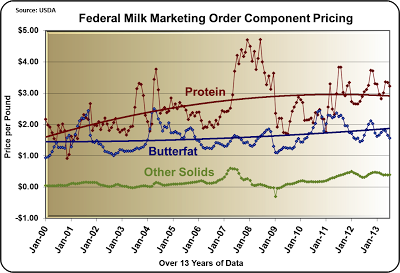US butter and cheese prices dropped in July, driving down the milk fat and milk protein prices.
Whey prices did increase giving a slight price boost to other solids, one of the three elements in the Class III price, which fell to $17.38 per hundredweight (cwt) from $18.02 per cwt in June.
Milk protein remains above the long-term trend line, which will increase over time. If it were not for the disruptive movement of prices in the 2008-09 period, protein prices would show a steady increase
Milk fat prices continue below their long term trends and at $1.57 per pound (lb). are near the long-term price of $1.50 per lb.
The price of other solids which are based on the US Department of Agriculture (USDA) National Agricultural Statistics Service (NASS) dry whey price continue to be the game changer with a price of $0.39 per lb.
The demand for whey continues to pressure the supply from cheese manufacturing keeping the price of whey at a level above the historic levels. This is expected to continue.

The update to the June inventories posted one week ago showed cheese inventories above historical levels. If this results in a decrease of cheese production as might be expected, it will also reduce whey availability and therefore maintain or increase the price of whey.
The three elements contributing to the Class III milk price remained consistent with the June chart. Milk fat contributed only 32% of the value in Class III milk. The remaining 68% came from milk protein and other solids, both of which are highly influenced by cheese production levels.

The inventories of cheese and butter are too high and this is influencing the price of milk protein and milk fat. Until the inventory levels are reduced, milk protein, milk fat, and the Class III price will be negatively influenced.
CME and NASS prices
There are two ways to trace dairy prices in the US - the first is the cash market held daily on the Chicago Mercantile Exchange (CME), the other is the NASS. Payment within the Federal Milk Marketing Orders is based on NASS data.
CME trading of cheese blocks and barrels is conducted daily and typically lasts for less than 15 minutes. Trading conducted here represents less than 1% of the cheese manufactured in the US so the market is characterized as very thinly traded. Some days, no cheese or butter is even sold in this auction. And because a thinly traded market can be manipulated, there is concern about using the CME data to price dairy products.
Therefore, the NASS survey was developed to establish pricing on a wider base. This is done weekly and data is summarized monthly for calculation of dairy product prices.
Because the CME auction is conducted daily and the data is readily available, the figures are available at the close of the daily auction. The NASS data collected by survey takes longer to collect, summarize, and publish.
The charts below show the comparison of the CME and NASS prices for butter and cheese.


Butter prices from the CME and NASS are almost identical.
However, the cheese prices from the NASS lag by about two weeks.

This does provide an opportunity to predict the movement of the NASS cheese prices and thereby predict the important Class III milk price that is the basis for payment for over 50% of the US milk market.
US-based John Geuss is the editor of US dairy commodities blog, MilkPrice.
For more of John's in-depth month-to-month dairy commodity price updates, click here.
